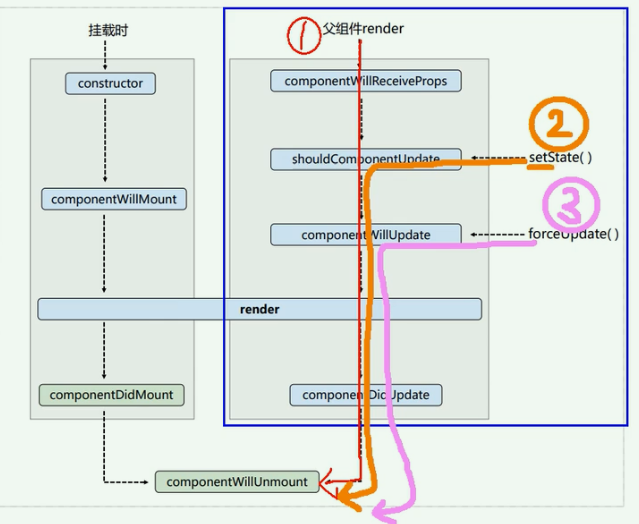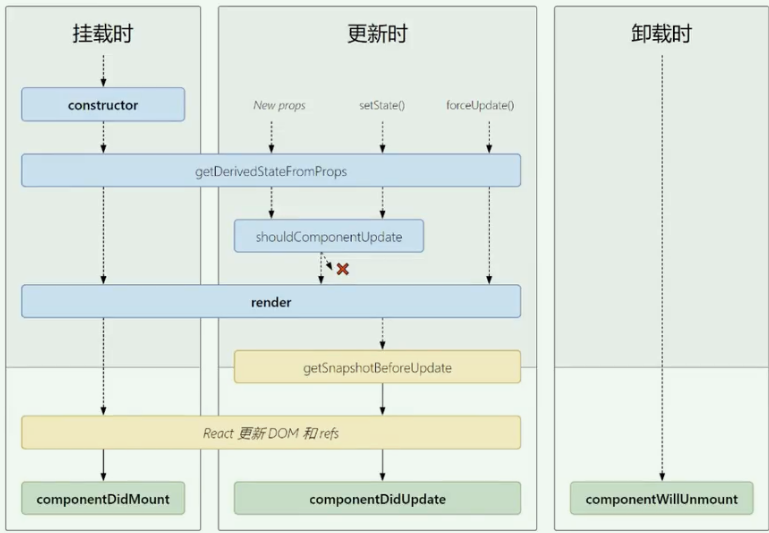对生命周期的理解:
1, 组件从创建到死亡,它会经历一些特定的阶段
2, React组件包含一系列钩子函数(生命周期回调函数),会在特定的时刻被调用
3, 我们在定义组件时,会在特定的生命周期回调函数中,做特定的工作
页面最后有对生命周期使用的总结:

//1. 创建类式组件
//生命周期回调函数 <=> 生命周期钩子函数 <=> 生命周期函数 <=> 生命周期钩子
//对生命周期的理解:
//1, 组件从创建到死亡,它会经历一些特定的阶段
//2, React组件包含一系列钩子函数(生命周期回调函数),会在特定的时刻被调用
//3, 我们在定义组件时,会在特定的生命周期回调函数中,做特定的工作
class Life extends React.Component{
//初始化状态
state = {opacity:1}
//组件挂载完毕
componentDidMount(){
this.timer = setInterval(()=>{
let {opacity} = this.state
opacity -= 0.1
if(opacity <= 0) {
console.log(opacity);
opacity = 1
}
console.log(opacity);
this.setState({opacity:opacity})
},1000)
}
componentWillUnmount(){
clearInterval(this.timer);
}
//调用时机: 初始化渲染,状态更新之后
render() {
//render 调用几次 1 + n(第一次渲染,然后当 state状态更新时,所以这里每当state更新一次,就会再次一次)
//所以把setInterval放在这里不合适
/* setInterval(()=>{
let {opacity} = this.state
opacity -= 0.1
if(opacity <= 0) {
console.log(opacity);
opacity = 1
}
console.log(opacity);
this.setState({opacity:opacity})
},1000) */
return (
<div>
<h1 style={{opacity:this.state.opacity}}>学不会, 怎么办</h1>
<button onClick={this.die}>不活了</button>
</div>
)
}
die = (event)=>{
//console.log(event.target);
//卸载组件
ReactDOM.unmountComponentAtNode(document.getElementById("test"));
}
}
ReactDOM.render(<Life/>,document.getElementById("test"))旧的生命周期的调用
class Count extends React.Component{
state = {count:0}
//生命周期函数 挂载时如下
//1, constructor(构造器)
//2, componentWillMount(组件将要挂载)
//构造器
constructor(props){
console.log("Count---constructor");
super(props)
}
//组件将要挂载的钩子
componentWillMount(){
console.log("Count---componentWillMount");
}
//组件挂载完毕的钩子
componentDidMount(){
console.log("Count---componentDidMount");
}
componentWillUnmount(){
console.log("Count---componentWillUnmount");
}
//组件是否应该更新(true---go,false---stop) 默认返回true
shouldComponentUpdate(){
console.log("Count---shouleComponentUpdate");
return true
//如果是false, 就不再往下走了
}
//组件将要更新的钩子
componentWillUpdate(){
console.log("Count---componentWillUpdate");
}
//组件更新完毕
componentDidUpdate(){
console.log("Count---componentDidUpdate");
}
render(){
console.log("Count---render");
return (
<div>
<h1>当前的统计总数为: {this.state.count}</h1>
<button onClick={this.add}>点击+1</button>
<button onClick={this.die}>卸载组件</button>
<button onClick={this.force}>不更改任何状态值,强制更新一下</button>
</div>
)
}
add = ()=>{
const {count} = this.state
this.setState({count:count+1})
}
//卸载组件按钮的回调
die = ()=>{
ReactDOM.unmountComponentAtNode(document.getElementById("test"))
}
force = ()=>{
this.forceUpdate();
}
}
ReactDOM.render(<Count/>,document.getElementById("test"))父子组件的调用:
class Parent extends React.Component{
//初始化状态值
state = {carName:"宝马"}
//更换车
changeCar = () =>{
this.setState({carName:"奥拓"})
}
render(){
return (
<div>
<h1>我是父组件</h1>
<button onClick={this.changeCar}>换车</button>
<Child carName={this.state.carName} />
</div>
)
}
}
class Child extends React.Component{
//componentWillReceiveProps 第一次接收 属性值 不执行
componentWillReceiveProps(props){
console.log("子组件",'componentWillReceiveProps',props);
}
shouldComponentUpdate(){
console.log("是否Ok",'shouldComponentUpdate');
return true;
}
componentWillUpdate(){
console.log("子组件",'compoentWillUpdate');
}
componentDidUpdate(){
console.log("子组件","componentDidUpdate");
}
render(){
console.log('子组件渲染');
return (
<div>
我是子组件,接收到汽车是 {this.props.carName}
</div>
)
}
}
ReactDOM.render(<Parent/>, document.getElementById("test"))新版本的生命周期

class Count extends React.Component{
state = {count:0}
//生命周期函数 挂载时如下
//1, constructor(构造器)
//2, componentWillMount(组件将要挂载)
//构造器
constructor(props){
console.log("Count---constructor");
super(props)
}
//组件挂载完毕的钩子
componentDidMount(){
console.log("Count---componentDidMount");
}
componentWillUnmount(){
console.log("Count---componentWillUnmount");
}
//组件是否应该更新(true---go,false---stop) 默认返回true
shouldComponentUpdate(){
console.log("Count---shouleComponentUpdate");
return true
//如果是false, 就不再往下走了
}
//派生的状态:不是从state得到,是从props得到
//此方法适用于罕见的用例,即 state 的值在任何时候都取决于 props, 可以使用此方法,但也可以完全不使用,即从地球上消失,没有作用
static getDerivedStateFromProps(props,state){
console.log("getDerivedStateFromProps",props,state);
//this.setState({count:props.count})
// return props
return null
}
//组件更新完毕
componentDidUpdate(preProps,preState,snapShot){
console.log("Count---componentDidUpdate",preProps,preState,snapShot);
}
//getSnapshotBeforeUpdate (信息状态在更新之前来个快照)
//同样,此用法很不常见
getSnapshotBeforeUpdate(){
console.log("更新快照","getSnapshotBeforeUpate");
//快照值: 任何值都可以做为快照值 字符串,数组,对象
return "庄子" //想传什么就传什么,传给componentDidUpdate
}
render(){
console.log("Count---render");
return (
<div>
<h1>当前的统计总数为: {this.state.count}</h1>
<button onClick={this.add}>点击+1</button>
<button onClick={this.die}>卸载组件</button>
<button onClick={this.force}>不更改任何状态值,强制更新一下</button>
</div>
)
}
add = ()=>{
const {count} = this.state
this.setState({count:count+1})
}
//卸载组件按钮的回调
die = ()=>{
ReactDOM.unmountComponentAtNode(document.getElementById("test"))
}
force = ()=>{
this.forceUpdate();
}
}
//ReactDOM.render(<Count count = {10}/>,document.getElementById("test"))
const e = React.createElement;
const domContainer = document.querySelector('#test');
const root = ReactDOM.createRoot(domContainer);
root.render(e(Count));1. 初始化阶段: 由ReactDOM.render()触发--初次渲染
1. constructor()
2. componentWillMount
3. render()
4. componentDidMount() =====> 常用
一般在这个钩子中做一些初始化的事, 例如:开启定时器,发送网络请求,订阅信息
2. 更新阶段: 由组件内部this.setState()或父组件render触发
1. shouldComponentUpdate()
2. componentWillUpdate()
3. render() =====> 必须使用的一个
4. componentDidUpdate()
3. 卸载组件: 由ReactDOM.unmountComponentAtNode()触发
1. componentWillUnmount() ===> 常用
一般在这个钩子中做一些收尾的事, 例如:关闭定时器,取消订阅消息
新的生命周期:
即将废弃:componentWillMount,componentWillUpdate(),componentWillReceiveProps
增加:
getDervedStatefrorProps(得到派生的状态从props),
getsrapchotEeloreUpdate
(以上两个用法极其罕见, 即使完全不会也没有关系)
